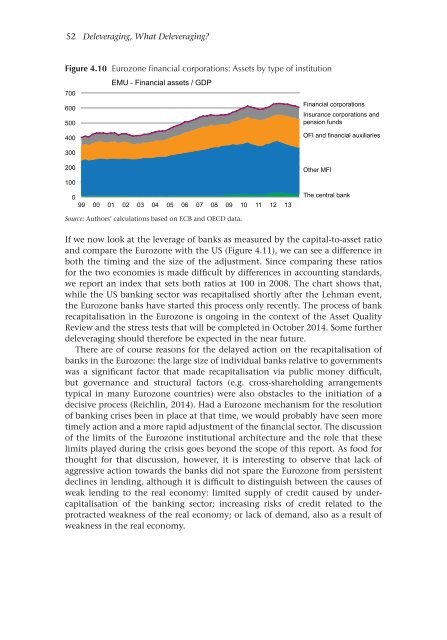1qGLG9p
1qGLG9p
1qGLG9p
You also want an ePaper? Increase the reach of your titles
YUMPU automatically turns print PDFs into web optimized ePapers that Google loves.
52 Deleveraging, What Deleveraging<br />
Figure 4.10 Eurozone financial corporations: Assets by type of institution<br />
700<br />
600<br />
500<br />
400<br />
300<br />
EMU - Financial assets / GDP<br />
Financial corporations<br />
Insurance corporations and<br />
pension funds<br />
OFI and financial auxiliaries<br />
200<br />
Other MFI<br />
100<br />
0<br />
99 00 01 02 03 04 05 06 07 08 09 10 11 12 13<br />
The central bank<br />
Source: Authors’ calculations based on ECB and OECD data.<br />
If we now look at the leverage of banks as measured by the capital-to-asset ratio<br />
and compare the Eurozone with the US (Figure 4.11), we can see a difference in<br />
both the timing and the size of the adjustment. Since comparing these ratios<br />
for the two economies is made difficult by differences in accounting standards,<br />
we report an index that sets both ratios at 100 in 2008. The chart shows that,<br />
while the US banking sector was recapitalised shortly after the Lehman event,<br />
the Eurozone banks have started this process only recently. The process of bank<br />
recapitalisation in the Eurozone is ongoing in the context of the Asset Quality<br />
Review and the stress tests that will be completed in October 2014. Some further<br />
deleveraging should therefore be expected in the near future.<br />
There are of course reasons for the delayed action on the recapitalisation of<br />
banks in the Eurozone: the large size of individual banks relative to governments<br />
was a significant factor that made recapitalisation via public money difficult,<br />
but governance and structural factors (e.g. cross-shareholding arrangements<br />
typical in many Eurozone countries) were also obstacles to the initiation of a<br />
decisive process (Reichlin, 2014). Had a Eurozone mechanism for the resolution<br />
of banking crises been in place at that time, we would probably have seen more<br />
timely action and a more rapid adjustment of the financial sector. The discussion<br />
of the limits of the Eurozone institutional architecture and the role that these<br />
limits played during the crisis goes beyond the scope of this report. As food for<br />
thought for that discussion, however, it is interesting to observe that lack of<br />
aggressive action towards the banks did not spare the Eurozone from persistent<br />
declines in lending, although it is difficult to distinguish between the causes of<br />
weak lending to the real economy: limited supply of credit caused by undercapitalisation<br />
of the banking sector; increasing risks of credit related to the<br />
protracted weakness of the real economy; or lack of demand, also as a result of<br />
weakness in the real economy.


